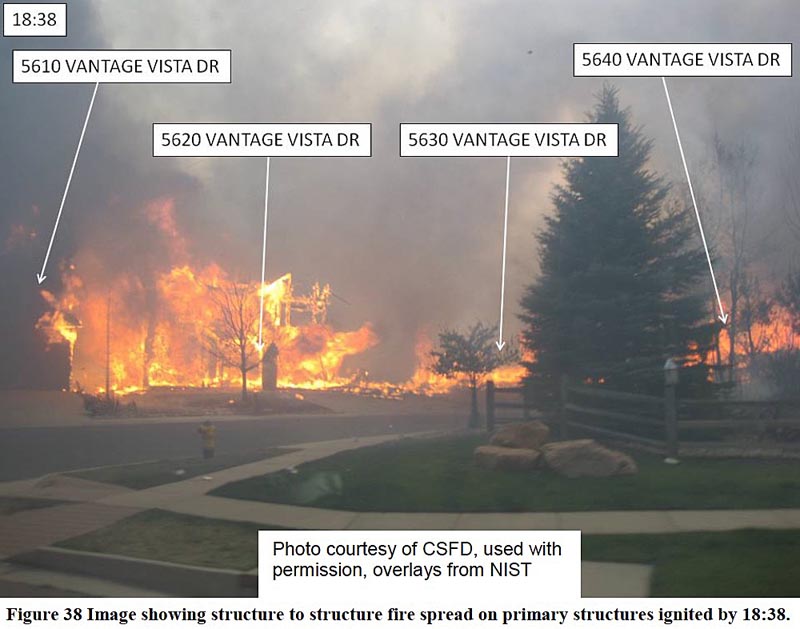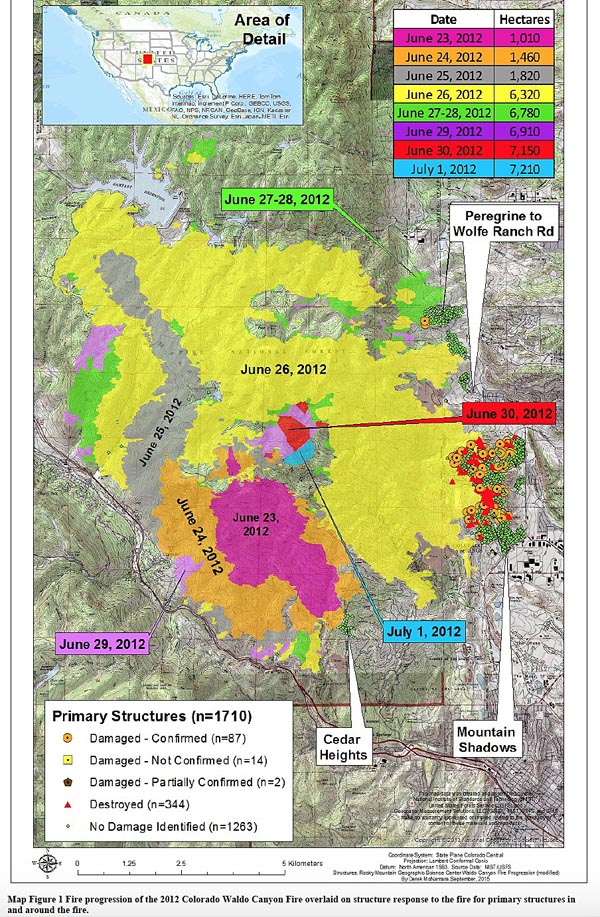 The National Institute of Standards and Technology has released a lengthy report on the Waldo Canyon Fire that burned 344 homes and killed two people in Colorado Springs, Colorado in June, 2012. (It can be downloaded here, but is a large file.)
The National Institute of Standards and Technology has released a lengthy report on the Waldo Canyon Fire that burned 344 homes and killed two people in Colorado Springs, Colorado in June, 2012. (It can be downloaded here, but is a large file.)
The 216-page document covers firefighting tactics, how structures ignited, defensible space, and how the fire spread, but does not address to any significant extent the management, planning, coordination, and cooperation between agencies, which were some of the largest issues.
The report was put together by five people, Alexander Maranghides, Derek McNamara, Robert Vihnanek, Joseph Restaino, and Carrie Leland.
At least three official reports have been written about the Waldo Canyon Fire, two from the city of Colorado Springs (here and here) and a third from the county sheriff’s office. However one of the most revealing was the result of an independent investigation by a newspaper, the Colorado Springs Independent, which revealed facts that were left out of the government-issued documents, including numerous examples of mismanagement by the city before and during the event.
The fire was first reported the evening of June 22, 2012 on the Pike National Forest. Due at least in part to the anemic response from the U.S. Forest Service, the fire was not located until after noon the following day. No aircraft were requested until firefighters were at the fire, more than 16 hours after the initial report.
The day the fire started there were eight large fires burning in Colorado and 16 uncontained large fires in the country. Four days later on June 26 when the Waldo Canyon Fire moved into Colorado Springs burning 344 homes and killing two people, there were 29 uncontained large fires burning in the United States.
However there were only nine large air tankers in the United States on U.S. Forest Service exclusive use contracts, down from the 44 we had 10 years before.
The 7-page Executive Summary of this newest report lists 4 primary findings, 37 technical findings, and 13 primary recommendations.
Primary findings:
- Defensive actions were effective in suppressing burning structures and containing the Waldo Canyon fire.
- Pre-fire planning is essential to enabling safe, effective, and rapid deployment of firefighting resources in WUI fires. Effective pre-fire planning requires a better understanding of exposure and vulnerabilities. This is necessary because of the very rapid development of WUI fires.
- Current concepts of defensible space do not account for hazards of burning primary structures, hazards presented by embers and the hazards outside of the home ignition zone.
- During and/or shortly after an incident, with limited damage assessment resources available, the collection of structure damage data will enable the identification of structure ignition vulnerabilities.
Three of the technical recommendations:
- Fire departments should develop, plan, train and practice standard operating procedures for responding to WUI fires in their specific communities. These procedures should result from scientifically mapping a community’s high- and low-risk areas of exposure to both the fire and embers generated during WUI events (as will be possible using the WUI Hazard Scale).
- A “response time threshold” for WUI fires should be established for each community. Fire departments have optimal “time-to-response” standards for reaching urban fires. Similar thresholds can, and should be, set for WUI fires.
- High-density structure-to-structure spacing in a community should be identified and considered in WUI fire response plans. In the Waldo Canyon fire, the majority of homes destroyed were ignited by fire and embers coming from other nearby residences already on fire. Based on this observation, the researchers concluded that structure spatial arrangements in a community must be a major consideration when planning for WUI fires.
Primary recommendations:
- Develop, plan, train and practice SOPs, based on better understanding of exposure and structure vulnerabilities, to enable rapid fire department response to WUI fires. SOPs need to account for responding, in the event of a specific WUI scenario, to both high and low exposure areas.
- A response time threshold for WUI fire situations needs to be developed based on increased understanding of exposure and structure vulnerabilities, the same way city fire departments have response thresholds for responding to building fires.
- Structure spatial arrangements in WUI areas where defensive actions are ineffective or unsafe need to be identified.
- Response plans for high density WUI areas, with the objective of fire not reaching these areas, need to be designed.
- Defensible space definitions need to be updated to emphasize that the main desired result is the ability for first responders to defend locations and recognize hazards of primary structures and dangerous configurations of topography and fuels outside the home ignition zone (HIZ).
- Additional research is needed to fully characterize the relationships between the spatial arrangement of houses and defensive action
- Hazards at the WUI, factoring in fuels, topography, and local weather need to be quantified. Fuels need to include wildland fuels and structural/residential fuels such as wood roofs, fences and combustible decks.
- A better understanding of exposure and structure vulnerabilities needs to be developed, including definitions for high and low fire and ember exposure areas
- Wildland fuel treatment standards to quantify exposure reduction for different topographical and weather conditions need to be developed.
- Construction standards and test methods need to be updated to capture representative fire and ember exposures from fuel treatments.
- Due to complexities associated with timeline reconstruction, exposure characterization and defensive actions, rapid post fire need to identify/count destroyed homes, and focus on documenting damage and destruction to the WUI environment, using current technology and comprehensive methods for documentation.
- Protocols for collection of ground and aerial imagery for pre-fire, during-fire and post-fire situations need to be developed.
- Consistent protocols for collection of damage information in a WUI environment need to be developed.
Below is an excerpt from the Executive Summary:
…The existing tactics, while effective for wildland firefighting might have significant limitations for WUI fires with close structure spacing where very rapid deployment might be necessary to limit fire spread and structural losses, if possible at all, for situations found at the Waldo Canyon Fire.
The data shows the apparatus response to MSC using current standard operating procedures (SOPs) as peaking at 20:30, almost three hours after the main fire front first reached the community and when there were between 248 to 286 primary structures ignited (i.e., 83 to 95 structures per hour). A paradigm shift might be required to enable very rapid deployment of agile resources coupled with equipment with significant water to safely and effectively fight WUI fires. Additionally, there is a need for identification and possibly increased treatment extending beyond the Home Ignition Zone (HIZ) of these high density and/or low structure to structure separation distance locations found near or adjacent to wildlands…
Here is a progression map of the Waldo Canyon Fire from the report. One thing it does not show is that the fire was reported on June 22, but firefighters on the ground did not find it until 16 hours later on June 23. Click the map to see a larger version.
Our congratulations to Derek McNamara who made this map and used very different colors to indicate the various dates. Too many graphics specialists use, for example, six similar shades of brown on a graphic, making it partially unusable.


So, wildland fires aren’t emergencies, but WUI fires are.
What does that mean for firefighter safety and training when responding to combined structural and wildland hazards, with high-value assets and civilian and firefighter lives at increased risk?
Is WUI firefighting different enough that more specific training needs to be developed?
Do all ICs have the tools they need to successfully and safely use both wildland and structural resources together?
Are there WUI equivalents or additional “watch out” situations beyond the standard wildland 18 (i.e., fighting fire near power lines, hazmat, structural fuel jackpot equivalents, evacuation congestion, etc.)?